


|
Commenced:
|
01/08/2012 |
|---|---|
|
Submitted:
|
18/12/2012 |
|
Last updated:
|
02/01/2019 |
|
Location:
|
2912 6th St, Boulder, Colorado, US |
|
Phone:
|
303-449-7219 |
|
Website:
|
http://cantelow.com |
|
Climate zone:
|
Cold Temperate |
(projects i'm involved in)
Back to Ann Cantelow's Home
Project: Ann Cantelow's Home
Posted by Ann Cantelow about 10 years ago
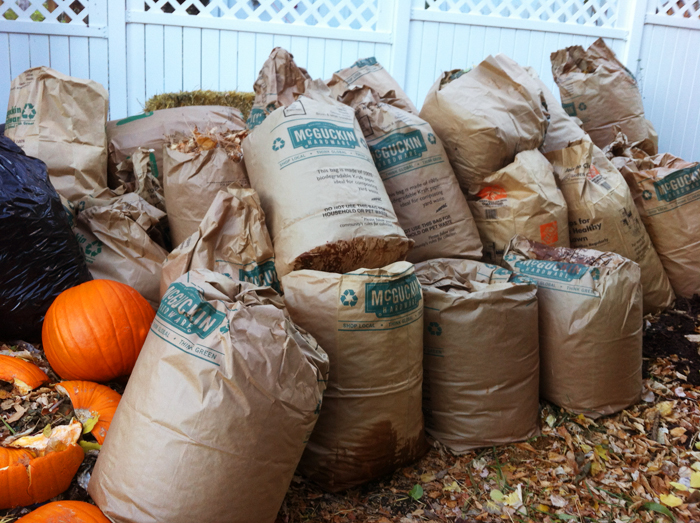 This last autumn was my second year collecting bagged leaves left out by neighbors for trash pickup. In 2013 the count was something over 130 bags collected. This year I had more experience (and kept a better count), got up to 254 bags plus a pickup load from someone I saw loading clippings to whom I offered my yard as a more convenient dumping place.
This last autumn was my second year collecting bagged leaves left out by neighbors for trash pickup. In 2013 the count was something over 130 bags collected. This year I had more experience (and kept a better count), got up to 254 bags plus a pickup load from someone I saw loading clippings to whom I offered my yard as a more convenient dumping place.
In 2013, I got most of my area covered with leaves to a depth of about 3-4 in/7-10 cm. In 2014, got the entire 330 sq meters/ 1/12 acre covered with 4-6 in/10-14cm. Leftover Halloween pumpkins, when found, are a nice bonus! There were less pumpkins to be found in 2014 than 2013- here's hoping the neighbors are becoming alert to the possibilities of composting them.
My job now with the mulch is to scare up good nitrogen sources. I have about 20 pounds of vetch and clover seeds ready to go out in spring once the leaves have had a chance to pack down a little. The fava beans and clover that I planted in 2014 to take advantage of the 2013 mulch seemed to be quite happy. Fava beans are delicious!
Part of my place is an enclosed yard that is about 150 sq feet/ 14 sq meters that had an unfortunate slant that led water to drain out under a fence. That's now been made level with up to about a foot of leaf mulch at the low end. In another area, I rolled up all the empty leaf bags and put them under about 8 in/ 20 cm of leaves to make a new working compost area of about 50 sq ft/ 4.5 sq mm. This area is now level and will no longer just drain out to the driveway.
That area in steps:
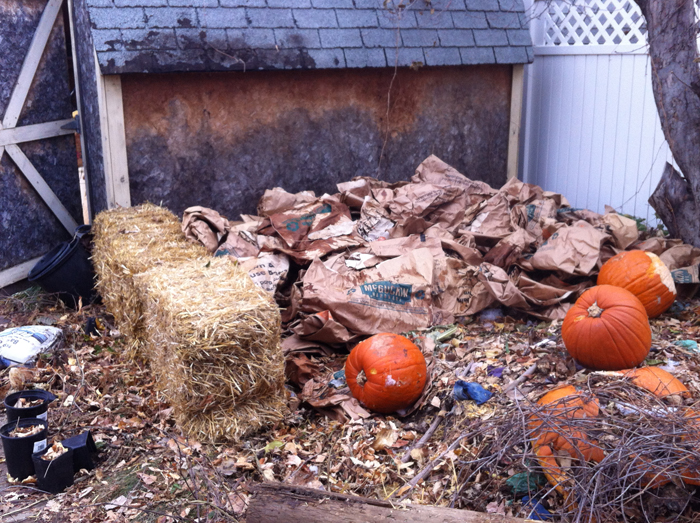
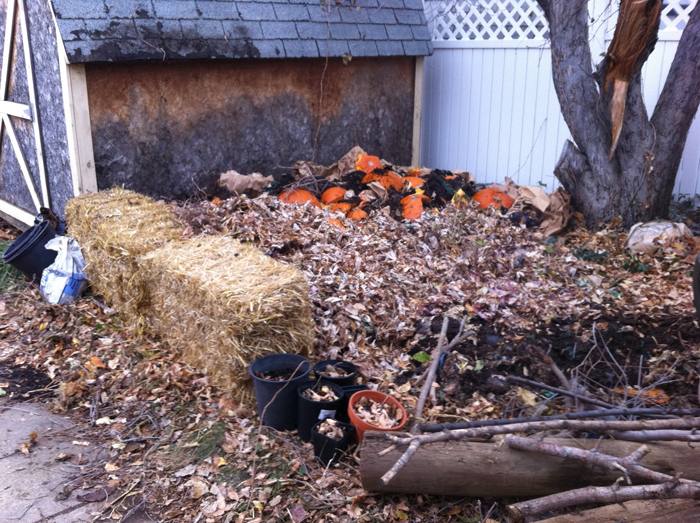
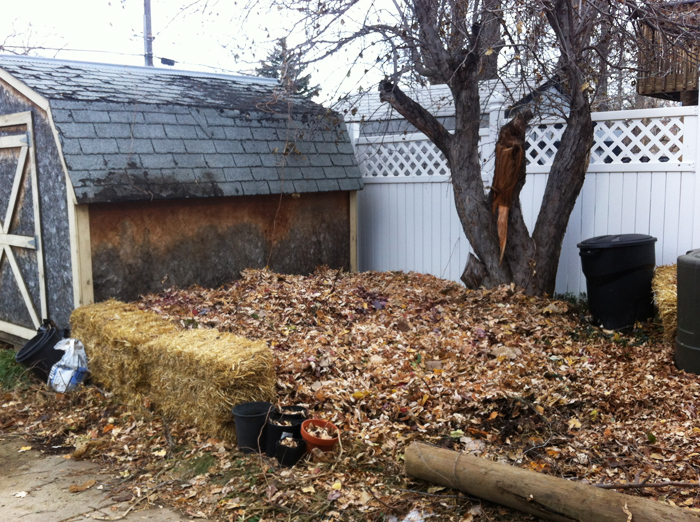
Back area mulching, about 3/4 done:
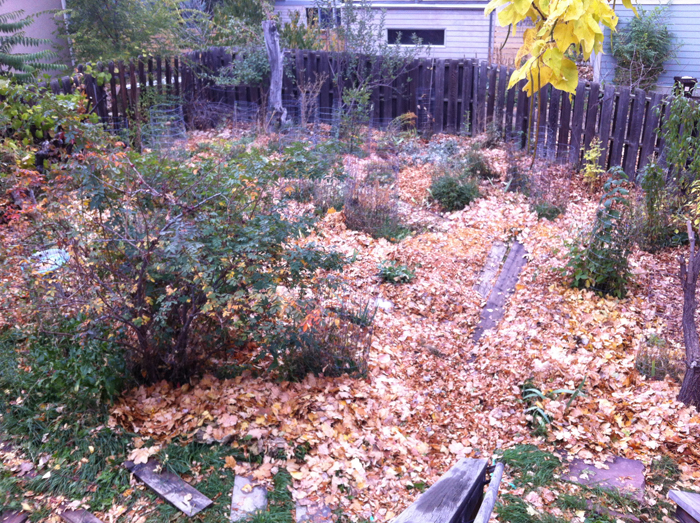
A disadvantage of taking neighbors' leaves is that they are not necessarily organic. I consider the advantage to the soil of having them to outweigh that. Another disadvantage: if you have bought cute little plants from the nursery, they'll likely get covered up and lost. Also my irises didn't bloom last year, probably because they're now buried too deep. A tip: if you do this, bring along some plastic bags to put over the tops of the bags in transit; I didn't do this and got leaves spilled all over making a mess in my car.
Other Updates
Deer are a big challenge in this garden. I've got pretty good at making deer cages for plants out of welded wire fencing. For now, building a deer fence around everything is kind of beyond my skill level. I chase deer out of the garden whenever I see them; this seems to cut down their visits by about half. I'll be working on strategies in the coming year. I've come to the realization I can't cover every square meter with deer cages! And you end up using more fencing with deer cages- so, I'll have to do something.
For walkways, I've started using planks and various sizes of wooden stepping stones. I want the hyphae from fungi in the soil to be able to travel under the walkways if they want to.
And, I'm allowing weeds to work in the garden to break up the soil. In 2013, there was a lot of Mullein, but 2014 saw less of that. There was also a lot of what I think is a small knotweed. In 2014, the mullein and knotweed seemed to mostly disappear. Chicory with its pretty blue flowers was dominant in 2014. I needed to pull bindweed away from the deer cages every once in awhile.
I'll plant some willows in 2015. I want to add sticks and twigs to my leaf mulch for the benefit of fungi, so want to set up a coppicing regime and willows are good for this, I have read. There are some types of willows that are somewhat drought tolerant, will look for those for this semi-arid climate.
Change of Focus
I'm thinking more about improving my soil these days, have dropped most thoughts for now of producing much food. I'm taking my time, waiting til later to plant many vegetables. I have planted a number of fruit and nut trees, though. Also alders, mimosas, a pea shrub, and caring for volunteer black locusts, all for their nitrogen fixing help. And nitrogen-fixing bushes- mountain mahogany and false indigo. Planning to add several silver buffaloberry plants in 2015.
This is all very fun!
Last summer:
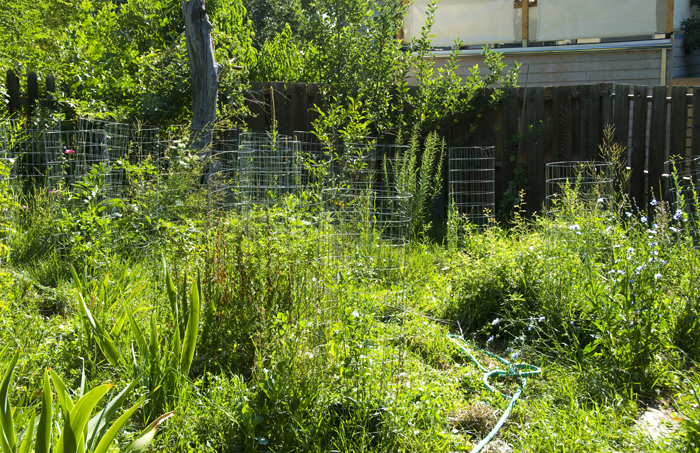
You must be logged in to comment.

Note: The various badges displayed in people profiles are largely honesty-based self-proclamations by the individuals themselves. There are reporting functions users can use if they know of blatant misrepresentation (for both people and projects). Legitimacy, competency and reputation for all people and projects can be evidenced and/or developed through their providing regular updates on permaculture work they’re involved in, before/after photographs, etc. A spirit of objective nurturing of both people and projects through knowledge/encouragement/inspiration/resource sharing is the aim of the Worldwide Permaculture Network.
 |
MemberA member is a permaculturist who has never taken a PDC course. These cannot become PDC teachers. Members may be novice or highly experienced permaculturists or anywhere in between. Watch their updates for evaluation. |
|---|---|
  |
Permaculture MatchmakerOne of these badges will show if you select your gender and the "I'm single, looking for a permaculture partner" option in your profile. |
 |
PDCPeople who claim to have taken a Permaculture Design Certificate (PDC) course somewhere in the world. |
 |
PDC VerifiedPeople who have entered an email address for the teacher of their PDC course, and have had their PDC status verified by that teacher. Watch their updates for evaluation. |
 |
PRI PDCPeople who’ve taken a Permaculture Research Institute PDC somewhere in the world. |
 |
PDC TeacherPeople who claim to teach some version of PDC somewhere in the world. |
 |
PRI TeacherWith the exception of the ‘Member’ who has never taken a PDC, all of the above can apply to become a PRI PDC Teacher. PRI PDC Teachers are those who the PRI recognise, through a vetting board, as determined and competent to teach the full 72-hour course as developed by Permaculture founder Bill Mollison – covering all the topics of The Designers’ Manual as well as possible (i.e. not cherry picking only aspects the teacher feels most interested or competent in). Such teachers also commit to focussing on the design science, and not including subjective spiritual/metaphysical elements. The reason these items are not included in the PDC curriculum is because they are “belief” based. Permaculture Design education concerns itself with teaching good design based on strategies and techniques which are scientifically provable. PRI PDC Teachers may be given teaching and/or consultancy offerings as they become available as the network grows. |
 |
Aid WorkerThe individual with this badge is indicating they are, have, or would like to be involved in permaculture aid work. As such, the individual may or may not have permaculture aid worker experience. Watch their updates for evaluation. |
 |
ConsultantThe individual with this badge is indicating they are, have, or would like to do paid permaculture design consultancy work. As such, the individual may or may not have permaculture consultancy experience. Watch their updates for evaluation. |
 |
Community ProjectCommunity projects are projects that help develop sustainable community interaction and increase localised resiliency. |